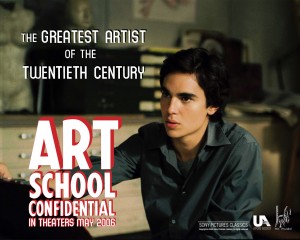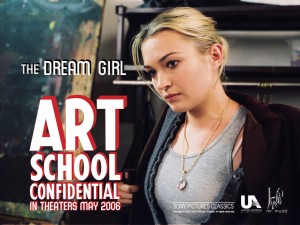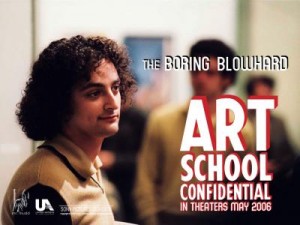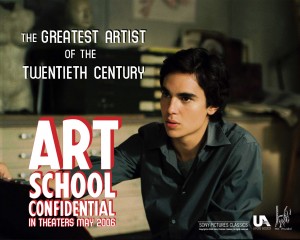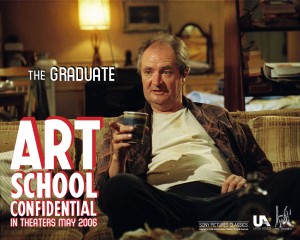From the Chicago Reader (May 12, 2006). — J.R.
Art School Confidential
** (Worth seeing)
Directed by Terry Zwigoff
Written by Daniel Clowes
With Max Minghella, Sophia Myles, Matt Keeslar, John Malkovich, Jim Broadbent, Joel David Moore, Ethan Suplee, Steve Buscemi, and Anjelica Huston
The 2001 live-action Ghost World was the first collaboration involving director Terry Zwigoff, cartoonist Daniel Clowes, and John Malkovich’s production company. Art School Confidential is the second. It’s far more ambitious than its predecessor and suffers from too many ideas rather than too few, making it an inspired, fascinating, and revealing mess. Holding it together is the same anger about the way art is taught that gave so much edgy life to the scenes with Illeana Douglas in Ghost World. Even if one disagrees with some of its points, as I do, it offers plenty to mull over.
Both films faintly echo a four-page catalog of Clowes’s gripes called “Art School Confidential” that appeared in his comic book Eightball. (Having taught courses in film and critical writing in a university art department in the mid-70s,I can testify that art-world careerism was the main preoccupation of both my students and my colleagues.) Clowes clearly felt alienated as an art student and has been spewing bile ever since. But as in the work of his fellow comic-book artist (and Zwigoff associate) Robert Crumb, self-hatred, misogyny, and misanthropy compete with the social criticism, to the point that they’re often difficult to separate. Art School Confidential‘s also full of Freudian confusion, which becomes obvious when we belatedly discover that the heroine dislikes the work of a particular painter simply because he’s her father.
Adding to the confusion are a lot of intemperate notions about the art world at large, expressed by artists, art students, art teachers (one played by Malkovich), and gallery owners. The basic activities of drawing and painting are sometimes seen as a form of bluffing and an escape from “real” life, and a key macho, post-Freudian premise seems to be that getting even with bullies and getting laid are the two main motives for becoming an artist — a thesis that’s illustrated as soon as the movie starts, when Clowes’s stand-in Jerome (Max Minghella) gets bullied on a playground. This thesis becomes complicated because some bullies and some women — most of them crazy or pathetic — also want to become artists. Even stranger, at least at first, is the implicit notion that many Americans hate artists so much they place a greater value on serial killers. But this is Clowes’s main insight, and if one stops to think how many more popular movies there are about serial killers than about artists, this no longer seems hyperbolic. And the social ramifications of this observation make up for all the confusion about why people produce art. Making things more interesting is the idea that murder sometimes gets confused with art, so that the “aesthetics” of psycho killings are treated with more respect by portions of the general public than the aesthetics of paintings.
I have to recount more of the plot to show how the movie seems to be saying or at least implying some of these things, so readers who don’t want it given away should stop here.
It’s characteristic of Clowes’s overall disaffection that the comic “Art School Confidential” lists “certain recurring character types [that] appear in every art-school class” and that in the movie Bardo (Joel David Moore), a classmate of Jerome’s, does the same thing. Yet there’s practically no overlap between the two lists, which makes me skeptical about both. In any case, the main “type” that’s missing from both lists is Bardo/Clowes — the adolescent wiseass who insists on reducing his classmates to such categories.
The fictional art school Jerome attends, Strathmore, is eventually shown to be in Manhattan when the characters walk past a subway stop, then appear at a trendy joint called Broadway Bob’s (lorded over by an uncredited Steve Buscemi) that’s clearly meant to be in Soho. But there’s little sense of place in either scene, perhaps because Zwigoff is mirroring the minimalist worlds of comics artists, including many who may have influenced Clowes. (Nancy‘s Ernie Bushmiller — after whom a character in the film is named — is an obvious example.) Clowes’s somewhat nihilistic world is even more psychologically and even less socially determined than Crumb’s. (Crumb’s work expresses a deeply felt nostalgia for an earlier American era that can’t help but encompass a social vision.)
Drawn to Strathmore by a photo of a nude artists’ model on a brochure and still a virgin when he arrives, Jerome is obviously provoked by Bardo’s remark during his first drawing class that “this school is like a pussy buffet” and by his later comment that Audrey (Sophia Myles), Jerome’s dream model, is “prime real estate.” The movie makes us wince at the gross insensitivity of such remarks, and it makes us wonder about Bardo’s admiration for Jimmy (Jim Broadbent), a cynical, embittered, and alcoholic alumnus we gradually realize is a serial killer who’s been terrorizing the campus. By this point we’ve also met Jerome’s two roommates — a blowhard film student who’s making a movie about the serial killings and a fashion major who’s in comic denial about his own gayness. What the closeted character is supposed to signify in Clowes’s critique of art schools is beyond me.
The film may want us to recoil from all the insensitivity, especially when it concerns the thwarting of Jerome’s libido and his serious artistic ambitions. Yet it turns him into a bit of a lout, a guy who willingly rejects his art for the possibility of success and sex: when a classmate who paints in a more primitive style lures Audrey away, Jerome, in an effort to win back her admiration and that of his teacher, rejects his own style and claims Jimmy’s brutal collage works are his own. Then we learn that the classmate is an underground cop hoping to nab the serial killer, and since one of Jimmy’s collages contains a key piece of evidence, Jerome becomes the prime suspect. The most interesting consequence of this is that it allows the movie to have a happy ending.


